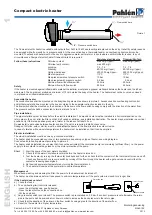
10
Designed for applications that require repeatable results and superior temperature
stability. These multi-purpose units are ideal for incubation and activation of cultures,
enzyme reactions, immunoassays, melting/boiling points, and a wide variety of other
laboratory procedures.
For best performance, the Dry Block Heater should be used in a stable environment.
The unit’s environment should have no air currents, drafts or temperature changes
and it cannot be placed in direct sunlight. The unit requires a stable electrical supply
that is free of voltage fluctuations. An unstable environment will adversely affect the
performance of the unit. For example, even minor air drafts or temperature changes
will adversely affect the unit’s ability to maintain a stable temperature.
1. Getting ready:
a. When using the external RTD probe, plug the RTD probe into the three (3) pin
DIN connector at the back of the unit and place the thermometer portion in the
thermometer well of the modular block. When using multiple blocks, place the
RTD probe in the front right modular block.
b. Press the standby button to change the unit from standby mode. The
temperature display, time display and probe indicator light will illuminate. When
not using the RTD probe, the plate indicator light will illuminate. The temperature
display will alternate between the actual and set-point temperatures.
2. Setting temperature:
a. Press the up/down arrows to the right of the temperature display until you reach
the desired temperature. Holding down either the up or down arrow will cause
the set temperature to change rapidly, a single pressing of either key will move
the set temperature by 0.1°C. When you release the button, the display will
blink off and then on, indicating the new set temperature has been accepted.
Once the set-point has been programmed and the keys are not being pressed,
press the on/off button to the right of the temperature display to activate the
heating function. A green indicator light will illuminate next to the on/off button
indicating the heating function is on. The actual and set-point indicator lights
will alternate between set and actual temperatures. There are three (3) audible
beeps to indicate the set-point temperature has been reached.
b. Set-point temperature adjustments can be made without interrupting heating
using the up/down arrows to the right of the temperature display. After the
change has been made and you release the button, the display will blink off and
then on indicating the new set temperature has been accepted.
c. To stop heating, press the on/off button to the right of the temperature display.
d. Allow time for the temperature to stabilize. The actual temperature displayed is
the temperature at the bottom of the modular block or of the RTD probe. Once
the displayed actual temperature agrees with the set temperature, several
minutes should be allowed for the temperature to stabilize throughout the block
evenly.
Overshoot protection: If the unit exceeds the set temperature by 10°C, the unit will
automatically stop heating.
3. Setting timed mode: Programmed time.
a. Press the up/down arrows to the right of the time display until you reach the
desired time.
b. Start this function by pressing the on/off button to the right of the time display,
the unit will run for the selected time. When using the timer in conjunction
with the heating function, when the time display reaches zero (0:00), four (4)
audible beeps will indicate the time down function is complete. Both the time
and heating functions will shut off automatically and the time display will default
back to the set time. To repeat for the same time, simply depress the on/off
button again.
c. To interrupt an automatic timing cycle before it is completed, press the on/
off button to the right of the time display. The time display will flash until you
resume the time function by pressing the on/off button again. This interrupt will
not stop the heating function, the heating function will stop only when the timer
reaches zero (0:00).
d
igital
d
ry
b
lock
H
eater
o
Perating
i
nstructions
EN












































